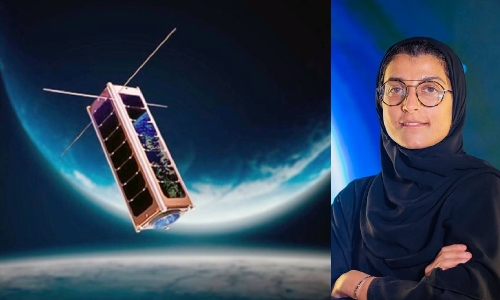Bahrain-UAE satellite Light-1 will be in orbit for 6 months
TDT | Manama
The Daily Tribune – www.newsofbahrain.com
Staff Reporter
The Bahrain-UAE joint nanosatellite Light-1 will be in orbit for the next six months, according to a leading UAE Space Agency official.
Light-1 was successfully deployed from the Japanese Experiment Module (KIBO) into orbit on February 3 under the supervision of the Japan Aerospace Exploration Agency.
It took five minutes to activate the launch sequence after the International Space Station received clearance from a command team on Earth.
In an exclusive interaction with The Daily Tribune, Heyam Al Blooshi, Acting Head of Space Standards Quality Department at UAE Space Agency, said the CubeSat will be in orbit for the next six months.
“It will send data to the Earth and also receive commands from our ground control team,” she said.
“Light-1 will start the region’s first scientific mission to monitor and study terrestrial gamma-ray flashes from lightning storms and cumulus clouds.”
According to scientists, there are two known kinds of gamma-ray phenomena associated with thunderclouds:
gamma-ray glows weak emissions which last about a minute, and shortlived terrestrial gamma-ray flashes (TGFs), which occur as lightning strikes and are much more intense than gamma-ray glows.
“Both occur in regions of thunderclouds sandwiched between layers of varying charge.
The charged regions accelerate electrons to near the speed of light.
At these speeds, referred to as relativistic, electrons that stay very close to the nuclei of nitrogen atoms in the air slow down a little and emit a telltale gamma-ray.
This is called bremsstrahlung radiation.”
The three-unit CubeSat, the most advanced of its kind, will measure charged particles above thunderstorms that release harmful levels of radiation and can endanger aircraft passengers.
The charged particles, otherwise known as terrestrial gamma-ray flashes, can expose air passengers to the equivalent of 400 chest X-rays in one flash.
The flashes can also play havoc with a plane’s electronics, putting passengers and crew at risk.
A special crystal detector on the nanosat will help measure the flashes and their potency.
Light-1’s gamma-ray detection system is designed and assembled with a unique layout making use of state-of-the-art detection devices.
It is competitive with bigger satellites and can make an impactful contribution to the comprehension of terrestrial gamma-ray flashes, according to Bahrain’s National Space Science Agency (NSSA).
The Light-1 satellite, thanks to its innovative technology, might be the pathfinder of future and larger missions targeting gamma rays.
Light-1 makes use of ‘scintillating’ crystals – a scintillator is a material that emits light when crossed by a subatomic particle and some crystals are very good scintillators.
The light emitted by the crystals is collected by sensors called photomultipliers and then processed by a dedicated electronic system.
Although the single components can be sourced from specialised companies, the assembled detection system is unique to Light-1.
The impact of high-energy gamma-ray emissions on the atmosphere, air traffic and human health, especially flight crews, will be studied.
These rays can penetrate aircraft structures, and therefore the data of Light-1 will improve understanding related to radiation exposure.
The team that worked on the design and construction of Light-1 included nine Bahrainis and ten Emiratis.
Related Posts

